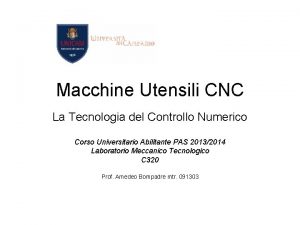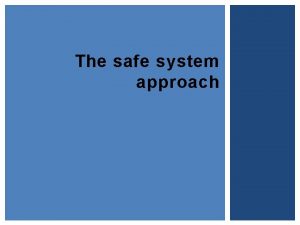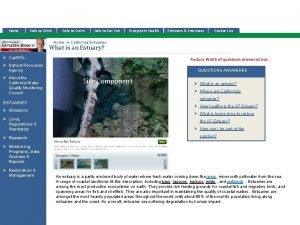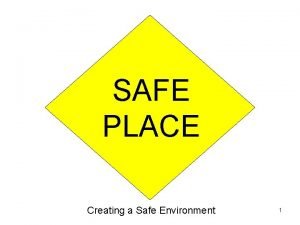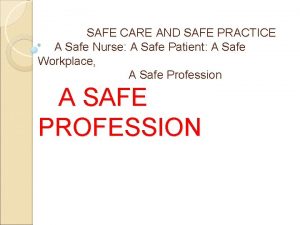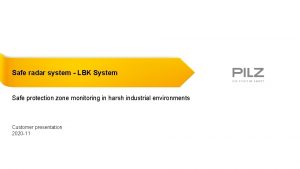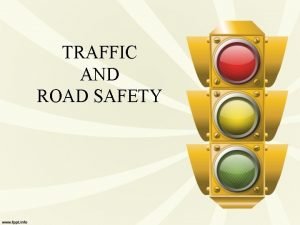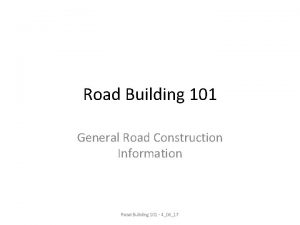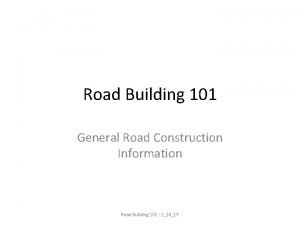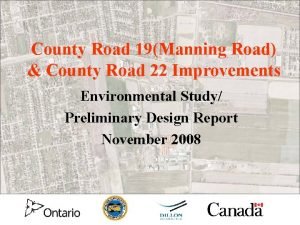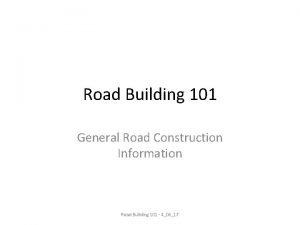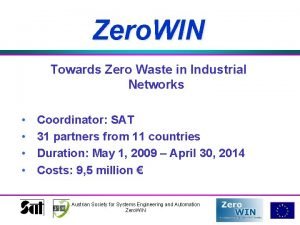The safe system approach Road to zero What










































- Slides: 42

The safe system approach


Road to zero What do you think?

Paradigm shift It’s not about eliminating crashes, but eliminating fatal and serious injuries. What determines whether a crash is a severe injury or minor injury (or better yet “Property Damage Only”) crash?

What is it? “The Safe System approach is regarded as international best practice in road safety and provides an outcome whereby death and serious injury are virtually eliminated amongst users of the road system. ” Reference: Austroads Report AP-R 560 -18 Towards Safe System Infrastructure: A Compendium of Current Knowledge

Yea, Ok, But … What is it? “Safe System is the management and design of the road system such that impact energy on the human body is firstly avoided or secondly managed at tolerable levels by manipulating speed, mass and crash angles to reduce crash injury severity. ” Reference: Austroads Report APR 560 -18 Towards Safe System Infrastructure: A Compendium of Current Knowledge

“safe system” approach Kinetic energy transfer kills road users The Safe System approach acknowledges that users make mistakes. The goal is to ensure redundancy in the system so that in the event of a crash, the impact forces released are within the boundaries of human tolerance and that no fatalities should occur and serious injuries are reduced. Source: Roads and Traffic Authority of New South Wales

Safe systems approach Four Guiding Principles: Safe system diagram adapted from Safer Roads, Safer Queensland: Queensland's Road Safety Strategy 2015– 21 1. People make mistakes that lead to road crashes 2. The human body has a physical tolerance to crash forces before harm occurs 3. Shared responsibilities among users and those who design, build and maintain vehicles and roads 4. Strengthen all parts of the system so users are protected if one part fails http: //www. oecd. org/publications/zero-road-deaths-and-serious-injuries-9789282108055 -en. htm

Paradigm shift Safety is an exercise of managing kinetic energy. What determines the level of transferable kinetic energy in a crash?

Australia’s safe system approach Officially endorsed by the Australian Transport Council in 2004 and adopted by all Australian state and territory road authorities Guides the development of National Road Safety Action Plans and National Road Safety Strategy • Adapt the road system to the “physical tolerance of its users” • Set speed limits so that avoiding death and serious injuries becomes a priority

Speed and Impact Severity Speed “We wipe off most our speed during the last moments of braking” Distance

Intersection conflict points Conflict points exist where vehicle travel paths cross one another (crossing conflicts), where vehicles from one traffic stream enter into another (merging conflicts), and at points vehicles depart a traffic stream (diverging conflicts). Conflict Points may be thought of as “Collision Potential” 16 Crossing Conflicts If a person commits an error (poor judgement or traffic control violation) Source: North Carolina DOT

Reduced left turn conflict intersections

collision angle Intersection crash severity is highly influenced by SPEED and ANGLE of IMPACT

Changing the angle of impact from 90° to 40° has about the same result as lowering the speed by 30 kph (19 mph) Source: DEVELOPMENT OF THE KINETIC ENERGY MANAGEMENT MODEL AND SAFE INTERSECTION DESIGN PRINCIPLES MONASH UNIVERSITY (Melbourne, Australia)

Is this why roundabouts are so effective at reducing severe crashes? - YES !!!

Safe system for intersections Safe System intersection design principles: - Minimize conflict points - Remove/simplify road user decisions - Minimize impact angles - Minimize entry and impact speeds https: //www. onlinepublications. austroads. com. au/items/AP-R 556 -17

Holistic & proactive “A Safe System requires understanding and managing the complex and dynamic interaction between operating speeds, vehicles, road infrastructure and road user behavior, in a holistic and integrated way, so that the sum of the individual parts of the system combine for a greater overall effect and if one part fails the other parts will still prevent serious harm from occurring. ” Zero Road Deaths and Serious Injuries: Leading a Paradigm Shift to a Safe System - October 2016 Excerpts from the Foreword http: //www. oecd. org/publications/zero-road-deaths-and-serious-injuries-9789282108055 -en. htm

A Safe System approach to intersection planning, design, and operations would build upon other ongoing initiatives, such as: Intersection Control Evaluation (ICE) Innovative Intersection Implementation Complete Streets Speed Management Strategies Systemic Safety Improvements Transportation System Performance 19

Chapter 1 of the NEW AASHTO Green Book New Framework for Geometric Design

2018 (7 th Edition) Green Book Changes • The “Major” change was a totally rewritten Chapter 1, entitled “New Framework for Geometric Design” • Some changes were also made to Chapters 2 through 10 Chapter 1 is reflective of: • NCHRP Report 785, Performance-Based Analysis of Geometric Design of Highways and Streets • NCHRP Report 839, A Performance-Based Highway Geometric Design Process • NCHRP Report 855, An Expanded Functional Classification System for Highways • NCHRP Report 876, Guidelines for Integrating Safety and Cost -Effectiveness Into 3 R Projects 21

22



AASHTO Highway Safety Manual (HSM) 2010 Release: • Rural Two-Lane Roads • Multilane Rural Highways • Urban/Suburban Arterials 2014 Supplement: • Freeway Segments • Ramp Terminals 2 ND Edition – 2020 (delayed) 125

What Is the HSM? • A tool to improve safety analyses • Encourages a “science-based” technical approach to safety analysis • Minimizes biased results Helps decision makers make more informed project design decisions 1 -26

Highway Safety Manual Integrating Safety into Decision Processes “Road safety management is in transition. The transition is from action based on experience, intuition, judgment, and tradition, to action based on empirical evidence, science, and technology…” Ezra Hauer (May 2005) University of Toronto, Canada 1 -27

Why Do We Need the HSM? ‘nominal safety’ refers to adherence to applicable design criteria and standards ‘substantive safety’ refers to the predicted, or actual, safety performance of a highway or proposed design 1 -28

Why Do We Need the HSM? Which model more closely describes the safety impacts of design elements? 29

Why Do We Need the HSM? Predictive Analysis: Uses crash, roadway, and traffic volume data to provide estimates of an existing or proposed roadway’s predicted safety performance. Helps agencies quantify the safety impacts of transportation decisions, similar to the way agencies quantify: • environmental impacts • traffic operations • pavement life • construction costs 130

Crash Prediction Models General Model Format: Crash frequency: Np = Nspf x CMFlw x CMFsw. . . x C Model Components: Safety performance function (SPF), Nspf Crash modification factors (CMF), CMFi Calibration factor, C Volume Predicted Crash Frequency Design Elements

Safety Performance Function (SPF) What are Safety Performance Functions? Mathematical Regression Models for Roadway Segments and Intersections: ►Developed from data for a number of similar sites ►Developed for specific site types and “base conditions” ►Function of only a few variables, primarily AADT ►Used to calculate the predicted crash frequency (crashes/year) for a set of base geometric and traffic control conditions 1 -32

Safety Performance Function (SPF) Plot of similar sites based on Traffic Volume and Crash Data Crashes per unit time 1. 2 XX X 1. 0 0. 8 0. 6 0. 4 0. 2 X X X XX X X 1000 2000 SPF = Best Fit Line 3000 4000 Average Daily Traffic 5000 1 -33

Safety Performance Function (SPF) Highway Safety Information System (HSIS) Participating States: 2010 HSM SPF’s and CMF’s were developed from roadway and crash data from the HSIS States 2014 Supplement on Freeways: CA, WA, & ME Source: www. hsisinfo. org 1 -34

Crash Modification Factor (CMF) Use of Multiple CMFs N predicted = Nspf x [CMF 1 X CMF 2 X…] • CMFs are Independent of other effects • Part C CMFs q (CMF 1, CMF 2, …. CMFn) q Derived from SPF data q Can use all applicable CMFs • Part D CMFs or CMF Clearinghouse q Derived from data separate from the SPF data q Limit multiple use to 3 or less 1 -35

Calibration Factor (C) Local Calibration Factor (C): (HSM Appendix A) ►Adjust HSM SPF-derived crash estimates to reflect local conditions ►Provide method to address for local variations such as: Climate, Driver populations, Animal populations, Crash Reporting Thresholds, and Crash Reporting System Procedures 1 -36

Default Values RECOMMENDATION: Replace Default Crash Statistics with Local Values All facilities: Crash severity and collision type Ratio of nighttime crashes (CMF for Lighting) Ratio of driveway-related crashes to total crashes (segments) Urban and suburban facilities: Pedestrian adjustment factor Bicycle adjustment factor. 1 -37

Empirical Bayes (EB) Adjustment Predicted vs. Expected crash frequency Nexpected = more reliable value EB improves the reliability of the estimated value and should be used when: • Evaluating the safety performance of an existing project • Evaluating effectiveness of a treatment for use at similar sites • A more reliable value is desired (e. g. Economic Analysis)

Empirical Bayes Adjustment If crash data is available, a better “expected crash frequency” value may be computed using an Empirical Bayes adjustment: Ø If X crashes were reported in last 3 years, “X/3” also represents an estimate of crash expectancy, but has uncertainty attached Ø Np represents “predicted” long-term average for all similar locations A weighted average of both Np and “X/3” is more reliable than either one alone: Ø Result is called “expected” average crash frequency Ne

Empirical Bayes Adjustment EB is applicable where: Ø No major changes in roadway geometrics and traffic control (“Do Nothing Alternative) Ø Road cross section is modified but number of through lanes remains the same Ø Minor changes in alignment (e. g. , flattening horizontal curves or adding turn lanes at intersections) ØPassing lane or a short four-lane section is added to a rural two-lane, two-way road to increase passing opportunities Ø Any combination of the above improvements EB is not applicable where: Ø Through lanes are added and/ or a new alignment is developed Ø Intersections that change number of approach legs and/or type of traffic control 1 -40

Proposed approach Incorporate Risk Based Surrogate Measures to enhance existing models ► Census data, DVRPC, FARS, GES to obtain ► Traditional roadway and traffic variables ► Non-traditional surrogate measures of risk characteristics by location ► crime, unemployment, mortgage default rates ► Do surrogate measures improve explanatory power of model? Are they worth the additional effort? 1 -41

Questions? 42
 Safe feed safe food
Safe feed safe food Safe people safe places
Safe people safe places What is paved and unpaved road
What is paved and unpaved road Zero defect zero effect
Zero defect zero effect Funzioni preparatorie cnc
Funzioni preparatorie cnc Safe systems approach
Safe systems approach Packet switching datagram and virtual circuit approach
Packet switching datagram and virtual circuit approach Theoretical models of counseling
Theoretical models of counseling Fine grained screening
Fine grained screening Approach approach conflict
Approach approach conflict Bandura's reciprocal determinism
Bandura's reciprocal determinism What is a research
What is a research Traditional approach in system analysis and design
Traditional approach in system analysis and design Deep learning approach and surface learning approach
Deep learning approach and surface learning approach Hình ảnh bộ gõ cơ thể búng tay
Hình ảnh bộ gõ cơ thể búng tay Frameset trong html5
Frameset trong html5 Bổ thể
Bổ thể Tỉ lệ cơ thể trẻ em
Tỉ lệ cơ thể trẻ em Gấu đi như thế nào
Gấu đi như thế nào Tư thế worm breton là gì
Tư thế worm breton là gì Chúa sống lại
Chúa sống lại Các môn thể thao bắt đầu bằng tiếng đua
Các môn thể thao bắt đầu bằng tiếng đua Thế nào là hệ số cao nhất
Thế nào là hệ số cao nhất Các châu lục và đại dương trên thế giới
Các châu lục và đại dương trên thế giới Cong thức tính động năng
Cong thức tính động năng Trời xanh đây là của chúng ta thể thơ
Trời xanh đây là của chúng ta thể thơ Mật thư tọa độ 5x5
Mật thư tọa độ 5x5 101012 bằng
101012 bằng độ dài liên kết
độ dài liên kết Các châu lục và đại dương trên thế giới
Các châu lục và đại dương trên thế giới Thơ thất ngôn tứ tuyệt đường luật
Thơ thất ngôn tứ tuyệt đường luật Quá trình desamine hóa có thể tạo ra
Quá trình desamine hóa có thể tạo ra Một số thể thơ truyền thống
Một số thể thơ truyền thống Cái miệng xinh xinh thế chỉ nói điều hay thôi
Cái miệng xinh xinh thế chỉ nói điều hay thôi Vẽ hình chiếu vuông góc của vật thể sau
Vẽ hình chiếu vuông góc của vật thể sau Nguyên nhân của sự mỏi cơ sinh 8
Nguyên nhân của sự mỏi cơ sinh 8 đặc điểm cơ thể của người tối cổ
đặc điểm cơ thể của người tối cổ V cc
V cc Vẽ hình chiếu đứng bằng cạnh của vật thể
Vẽ hình chiếu đứng bằng cạnh của vật thể Phối cảnh
Phối cảnh Thẻ vin
Thẻ vin đại từ thay thế
đại từ thay thế điện thế nghỉ
điện thế nghỉ




